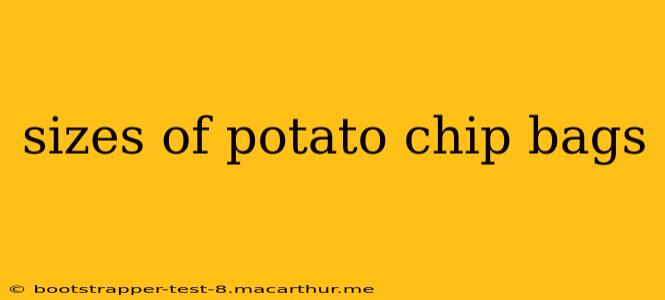Potato chips. That crunchy, salty, irresistible snack. But have you ever stopped to think about the sheer variety in the sizes of the bags they come in? From the single-serving bag perfect for a quick snack to the family-sized behemoth meant for sharing (or not!), the world of potato chip bag sizes is surprisingly complex. This article delves into the common sizes, the reasons behind the variations, and answers some frequently asked questions about these ubiquitous snack containers.
What are the standard sizes of potato chip bags?
There's no single, universally standardized system for potato chip bag sizes. Manufacturers vary considerably, and even within a brand, the actual weight and dimensions can fluctuate. However, we can categorize them into general size ranges:
-
Single-Serve/Snack Bags: These are typically small, individually portioned bags, perfect for lunchboxes or a quick snack on the go. Weight usually ranges from 1 to 2 ounces (28-57 grams).
-
Standard/Regular Bags: This is the most common size found in supermarkets and convenience stores. Weights generally range from 6 to 10 ounces (170-283 grams).
-
Family/Party Bags: These larger bags are designed for sharing (although we understand the temptation to keep them all to yourself!). They typically weigh between 10 and 20 ounces (283-567 grams) or even more.
-
Bulk/Club Bags: Sold primarily in bulk retailers like Costco or Sam's Club, these are massive bags containing several pounds of chips, perfect for large gatherings or those with a serious chip craving. Weights can range from 20 ounces (567 grams) to several pounds.
It's important to note that these are just general guidelines. Specific weights and dimensions will vary depending on the brand, the type of chip (e.g., thick-cut, ruffled), and even the flavor.
Why are there so many different sizes of potato chip bags?
The variety in potato chip bag sizes caters to a diverse market. Different bag sizes serve different needs and consumption patterns:
-
Consumer Demand: People have varying needs – a single-serve bag for a quick snack, a family-sized bag for a movie night, and bulk bags for large parties or those with high consumption. The variety of sizes reflects this diverse consumer demand.
-
Marketing Strategies: Different bag sizes allow manufacturers to target different customer segments and price points. Smaller bags are often more expensive per ounce, while larger bags offer better value for money.
-
Packaging Efficiency: Manufacturers also consider packaging and shipping efficiency when choosing bag sizes. Larger bags are generally more cost-effective to transport and store.
What is the average weight of a bag of potato chips?
The average weight of a bag of potato chips depends heavily on the size of the bag, as discussed above. However, the most common size (the standard/regular bag) generally falls within the 6-10 ounce (170-283 gram) range.
How many chips are in a standard bag of potato chips?
There is no fixed number of chips in a standard bag. The number varies depending on the size and cut of the chips, as well as any potential variations in manufacturing. However, you can expect several dozens of chips in a regular-sized bag.
Are there any environmental concerns about potato chip bag sizes and packaging?
Yes, the packaging of potato chip bags is a significant environmental concern. Most bags are made from non-biodegradable materials, leading to waste. Manufacturers are increasingly exploring more sustainable packaging options, such as compostable or recyclable materials. Consumers can also play a role by properly recycling bags where possible and reducing their consumption.
The size of the bag is also relevant here. Smaller bags might generate less waste per serving, but buying many small bags could increase the overall packaging waste compared to purchasing a larger, family-size bag.
This comprehensive look at potato chip bag sizes clarifies the diverse range available, the reasoning behind it, and the associated environmental considerations. Understanding these factors empowers consumers to make more informed choices about their snack purchases.
